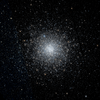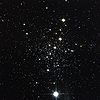Shapleyho–Sawyerové třída koncentrace hvězd
Shapleyho–Sawyerové třída koncentrace hvězd je klasifikace kulových hvězdokup podle míry zhuštění hvězd v jejich středu.[1] K označení třídy se používají římské číslice v rozsahu od I do XII - nejvíce zhuštěné hvězdokupy, jako například Messier 75, patří do třídy I a nejméně zhuštěné hvězdokupy (např. NGC 4372) do třídy XII. Některé zdroje však třídu koncentrace označují arabskými číslicemi.[2]
Historie
Mezi lety 1927 až 1929 začali Harlow Shapley a Helen Sawyerová Hoggová třídit kulové hvězdokupy podle míry zhuštění jejich hvězd směrem ke středu. Tento způsob třídění se stal známým jako Shapleyho–Sawyerové třída koncentrace hvězd.[3]
Tabulka tříd s příklady
| Třída[4] | Popis | Příklad |
|---|---|---|
| I | Vysoké zhuštění hvězd směrem ke středu | |
| II | Hustý střed | |
| III | Výrazné jádro z hvězd | |
| IV | Střední až bohatší zhuštění | |
| V | Poněkud větší zhuštění | |
| VI | Střední zhuštění | |
| VII | Střední zhuštění | |
| VIII | Spíše volné zhuštění směrem ke středu | |
| IX | Volné zhuštění směrem ke středu | |
| X | Volné zhuštění | |
| XI | Velmi volné zhuštění směrem ke středu | |
| XII | Skoro žádné zhuštění směrem ke středu |
Reference
V tomto článku byl použit překlad textu z článku Shapley–Sawyer Concentration Class na anglické Wikipedii.
- ↑ SHAPLEY, Harlow; SAWYER HOGG, Helen. A Classification of Globular Clusters. S. 11–14. Harvard College Observatory Bulletin [online]. Srpen 1927 [cit. 2017-01-16]. Roč. 849, s. 11–14. Dostupné online. Bibcode:1927BHarO.849...11S. (anglicky)
- ↑ The NGC/IC Project [online]. [cit. 2017-01-16]. Dostupné v archivu pořízeném dne 2009-05-28. (anglicky)
- ↑ SAWYER HOGG, Helen. Harlow Shapley and Globular Clusters. S. 336–346. Publications of the Astronomical Society of the Pacific [online]. Říjen 1965 [cit. 2017-01-16]. Roč. 77, čís. 458, s. 336–346. Dostupné online. DOI:10.1086/128229. Bibcode:1965PASP...77..336S. (anglicky)
- ↑ BURTON, Jeff. Shapley–Sawyer Globular Cluster Concentration Class [online]. 2011-07-26 [cit. 2017-01-16]. Dostupné v archivu pořízeném z originálu. (anglicky)
Média použitá na této stránce
en:Messier 54 globular cluster by en:Hubble Space Telescope; 3.5′ view
The dazzling stars in Messier 15 look fresh and new in this image from the NASA/Hubble Space Telescope, but they are actually all roughly 13 billion years old, making them some of the most ancient objects in the Universe. Unlike another recent Hubble Picture of the Week, which featured the unusually sparse cluster Palomar 1, Messier 15 is rich and bright despite its age.
Messier 15 is a globular cluster — a spherical conglomeration of old stars that formed together from the same cloud of gas, found in the outer reaches of the Milky Way in a region known as the halo and orbiting the Galactic Centre. This globular lies about 35 000 light-years from the Earth, in the constellation of Pegasus (The Flying Horse).
Messier 15 is one of the densest globulars known, with the vast majority of the cluster’s mass concentrated in the core. Astronomers think that particularly dense globulars, like this one, underwent a process called core collapse, in which gravitational interactions between stars led to many members of the cluster migrating towards the centre.
Messier 15 is also the first globular cluster known to harbour a planetary nebula, and it is still one of only four globulars known to do so. The planetary nebula, called Pease 1, can be seen in this image as a small blue blob to the lower left of the globular’s core.
This picture was put together from images taken with the Wide Field Channel of Hubble's Advanced Camera for Surveys. Images through yellow/orange (F606W, coloured blue) and near-infrared (F814W, coloured red) filters were combined. The total exposure times were 535 s and 615 s respectively and the field of view is 3.4 arcminutes across.The high concentration of stars within globular clusters, like Messier 12, shown here in an image from the NASA/ESA Hubble Space Telescope, makes them beautiful photographic targets. But the cramped living quarters in these clusters also makes them home to exotic binary star systems where two stars are locked in tight orbits around each other and matter from one is gobbled up by its companion, releasing X-rays. It is thought that such X-ray binaries form from very close encounters between stars in crowded regions, such as globular clusters, and even though Messier 12 is fairly diffuse by globular cluster standards, such X-ray sources have been spotted there.
Astronomers have also discovered that Messier 12 is home to far fewer low-mass stars than was previously expected (eso0604). In a recent study, astronomers used the European Southern Observatory’s Very Large Telescope at Cerro Paranal, Chile, to measure the brightness and colours of more than 16 000 of the globular’s 200 000 stars. They speculate that nearly one million low-mass stars have been ripped away from Messier 12 as the globular has passed through the densest regions of the Milky Way during its orbit around the galactic centre.
It seems that the serenity of this view of Messier 12 is misleading and the object has had a violent and disturbed past.
Messier 12 lies about 23 000 light-years away in the constellation of Ophiuchus (The Serpent Bearer). This image was taken using the Wide Field Channel of Hubble’s Advanced Camera for Surveys. The colour image was created from exposures through a blue filter (F435W, coloured blue), a red filter (F625W, coloured green) and a filter that passes near-infrared light (F814W coloured red). The total exposure times were 1360 s, 200 s and 364 s, respectively. The field of view is about 3.2 x 3.1 arcminutes.en:Messier 30 globular cluster by en:Hubble Space Telescope; 3.5′ view
Autor: HST / Fabian RRRR (talk), Licence: CC BY-SA 3.0
Color rendering is done by by Aladin-software (2000A&AS..143...33B.)
Messier 68 globular cluster by Hubble Space Telescope; 3.32′ view
Globular cluster en:Palomar 12 by Hubble Space Telescope 3.36′ view, North is 27° counterclockwise























